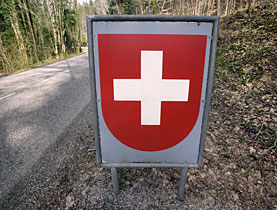Migrant labour contributes to Swiss prosperity

Switzerland is a magnet destination for workers from member countries of the Organisation for Economic Cooperation and Development, according to a study on migration.
Immigration is clearly above the OECD average and has been described as “good news” for the country.
Comparative figures presented in Paris show that in 2006, a total of 86,300 migrants came to Switzerland and were granted a residence permit of more than a year.
The increase over the previous year was ten per cent, in stark contrast to the OECD average of five per cent.
While there is no shortage of voices against the increasing numbers of foreigners in Switzerland – they represent more than one in five of the total population of 7.6 million – there are many who see the advantages for the country.
“Sustained growth”
“It is very good news. The sustained growth of the Swiss economy in recent years could not have materialised had it not been for the immigration of mainly well-qualified immigrants from Europe and overseas,” Kurt Rohner, a deputy vice-director of the Federal Migration Office, told swissinfo.
“Most of the foreigners who come to Switzerland come for work. They would not come here if no jobs were available. If the economy slows down, so will the influx of new residents.”
An OECD migration expert, Thomas Liebig, echoed Rohner’s observation.
“In many OECD countries, migration and the mobilisation of national resources have come to play an important role in covering the needs on the labour market.”
If the rise in immigration to Switzerland from OECD countries continues at the same pace observed since 2001, it will easily compensate for the falling numbers among the domestic working population, the study said.
It calculated that the Swiss working population would grow by eight per cent; without immigration it would decline by three per cent.
Temporary migration
Switzerland also features among the leaders when it comes to temporary migration. In 2006, almost 117,000 people came to work in Switzerland for a limited amount of time. This represents six times more than other OECD countries when compared with their populations.
The study also showed that 70 per cent of immigrants came to Switzerland in the framework of the free movement of people agreement between Switzerland and the European Union.
In Austria, Belgium, Denmark and Germany, this category represented only half of all migrants, while the proportion was as low as 20 per cent for France, Italy and Portugal.
The OECD report said that member countries should adapt their labour migration policies more closely to likely future demand for workers in all areas of their economies, opening up to lower-skilled workers as well as to those with high qualifications.
“I’m positive that Swiss labour migration policies are already taking into consideration precisely this notion. We try to make the labour market as flexible as reasonably possible, attracting especially qualified workers from the EU as well as highly skilled employees from other states all over the world,” Rohner said.
“But we certainly don’t need any further legislation, for example, for seasonal workers. It is most important, however, that Switzerland maintains its attractiveness both as a business location and a place to live.”
He added that the new federal law on foreigners that came into force at the beginning of this year put special emphasis on the integration of all the foreigners already in Switzerland and those yet to come.
“The focus of the law therefore acknowledges our need of foreigners, especially for the present and future wellbeing of our country and its economy.”
swissinfo, Robert Brookes
Inflows of top ten nationalities
1) Germany
2) Portugal
3) France
4) Italy
5) Serbia and Montenegro
6) Britain
7) United States
8) Turkey
9) Austria
10) Spain
Immigration into Switzerland increased in 2006, reaching a total of 102,700 people, 63% of whom came from a European Union country. This was the highest level since the beginning of the 1990s.
Germans and Portuguese remained the two largest groups, accounting respectively for 24% and 12% of new arrivals.
There was a decline in immigration from Italy (5%), Serbia (5%) and Spain (5%), which once used to be the main countries providing foreign workers.
In 2006, 10,530 asylum applications were filed (500 more than in 2005), a trend towards levelling off that marked, together with 2005, the lowest levels since the end of the 1980s.
The number of naturalisations rose significantly (20%) to about 46,700 in 2006, following legal changes that came into force on January 1, 2006.
This was the highest level seen in several decades. Serbian nationals formed the largest group among those granted Swiss citizenship and accounted for more than 25% of all naturalisations (about 11,700 people).

In compliance with the JTI standards
More: SWI swissinfo.ch certified by the Journalism Trust Initiative











You can find an overview of ongoing debates with our journalists here . Please join us!
If you want to start a conversation about a topic raised in this article or want to report factual errors, email us at english@swissinfo.ch.